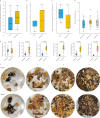Unexpected worker mating and colony-founding in a superorganism
- PMID: 37679330
- PMCID: PMC10484907
- DOI: 10.1038/s41467-023-41198-6
Unexpected worker mating and colony-founding in a superorganism
Abstract
The emergence of caste-differentiated colonies, which have been defined as 'superorganisms', in ants, bees, and wasps represents a major transition in evolution. Lifetime mating commitment by queens, pre-imaginal caste determination and lifetime unmatedness of workers are key features of these animal societies. Workers in superorganismal species like honey bees and many ants have consequently lost, or retain only vestigial spermathecal structures. However, bumble bee workers retain complete spermathecae despite 25-40 million years since their origin of superorganismality, which remains an evolutionary mystery. Here, we show (i) that bumble bee workers retain queen-like reproductive traits, being able to mate and produce colonies, underlain by queen-like gene expression, (ii) the social conditions required for worker mating, and (iii) that these abilities may be selected for by early queen-loss in these annual species. These results challenge the idea of lifetime worker unmatedness in superorganisms, and provide an exciting new tool for the conservation of endangered bumble bee species.
© 2023. Springer Nature Limited.
Conflict of interest statement
The authors declare no competing interests.
Figures




References
-
- Wheeler WM. The ant-colony as an organism. J. Morphol. 1911;22:307–325.
-
- Boomsma JJ, Gawne R. Superorganismality and caste differentiation as points of no return: how the major evolutionary transitions were lost in translation. Biol. Rev. 2018;93:28–54. - PubMed
-
- Boomsma, J. J. Domains and major transitions of social evolution (Oxford University Press, New York. 2022).
-
- Maynard, S. J. & Szathmáry, E. The major transitions in evolution. Chapter 2: Group formation, relatedness and the evolution of multicellularity (Oxford New York. Press, 1995).
Publication types
MeSH terms
LinkOut - more resources
Full Text Sources

